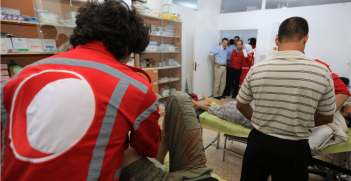Terrorism: What do Attacks in Europe Mean for Australia?

Australians have been horrified and mesmerised by the terrorist attacks in Istanbul, Brussels, Munich, Paris and Nice. Cities that are so familiar to us; people being indiscriminately killed as they go about their normal lives. What do these attacks mean for Australia, and should we be concerned?
Prime Minister Malcolm Turnbull’s response has been calm and cautious. Australia has good arrangements, he says, and some natural benefits of geography and distance. But in the wake of the Brussels attack in March, Turnbull reminded us that the terror alert level in Australia remained “probable: a terror attack is likely”. Following last month’s Nice attack he has directed a review of mental health factors in terrorism and whether there needs to be improved access to mental health information for counter-terrorism investigators.
These messages are mature and helpful. Turnbull’s right to point to 2014’s considered threat assessment of the terror alert level. And to highlight key issues from the overseas experience, such as mental health. But there are additional lessons Australia can take from Europe.
Here are five of the most important right now.
1. Geography will not protect Australia from terrorist attacks
Islamist groups are increasingly seeking to strike in the West, and Australia has been named on ISIS’s lists of target countries, ranking third for mentions behind the US and UK. The attacks on Brussels and Istanbul airports, in particular, saw victims from around the world. And with around 1,000 known ISIS supporters in Australia under investigation, three attacks and nine Islamist extremist plots disrupted to date, would-be perpetrators are already here. Australia should be prepared for more successful attacks on Australia at home and abroad.
2. Think outside the jurisdiction
Reviews of the Brussels attacks showed serious coordination and communication problems between Belgian jurisdictions, particularly along the cultural and linguistic divide between Flemish and French. While not facing the same level of attacks to date, Germany also has 16 state jurisdictions, each with their own counter-terrorism police and intelligence organisations required to work with the national bodies, and that may cause similar problems. Australia’s internal counter-terrorism arrangements, including with New Zealand, are close and mature. But we need to realistically consider how well current arrangements work and continually work to ensure these are optimal. A first step would be to institute regular and realistic multijurisdictional exercises, including Cabinet-level crisis arrangements, so that all key players are familiar and practiced with arrangements before a real incident occurs.
3. Be pragmatic with partnerships
Australia has very good intelligence-sharing arrangements with Five-Eyes partners, and varying levels of relationships with other countries, typically based on key bilateral agency relationships. But plots, attacks and investigations will not only involve those we work with best. Belgium and Turkey had both been criticised by European neighbours for some of their counter-terrorism capabilities, but both have proven essential partners for French counter-terrorism investigators in relation to the Paris and Nice attacks. Australia’s neighbours will be vital for Australia’s future counter-terrorism efforts. The Bali bombings remain the worst attack on Australians; the recent thaw in Australia’s relationship with Indonesia, supported by a bilateral agreement on counter-terrorism and joint sponsorship of the regional Counter-Terrorism Financing Summit initiative has put this relationship back where it needs to be. Where capabilities are of concern, help should be provided through dialogue and partnerships. The relationship with Indonesia needs to be deepened and sustained, and the model expanded through Southeast Asia.
4. Plan for high operational tempo
Just over 18 months ago, French, Belgian and German counter-terrorism officials were managing investigations and counter-terrorism reform in a relatively steady state, much like Australia. All are now caught in a cycle of operation, response, review and investigation that leaves little capacity for a strategic approach to counter-terrorism, or much else. While Australian authorities are dealing with more counter-terrorism investigations than ever before—stretching investigative resources in particular—this would be increased in magnitude should Australia face a mass casualty terrorist attack or a series of smaller attacks. Government, investigators, first responders and key business entities should plan now for contingency arrangements to respond to such a high operational tempo. First steps for contingency planning would include reviewing existing arrangements—including recommendations from previous reviews—and instituting regular exercises to test assumptions, capability and decision-making against scenarios informed by Australia’s threat assessments and the overseas experience.
5. Institutionalise lessons learned
In the immediate aftermath of the attacks in Europe, questions began to be asked about how they happened and what governments could do to prevent further attacks. France had only 10 months between the Charlie Hebdo attack and the larger November Paris attacks. Despite the short time frame, some reforms were made to improve intelligence coordination and sharing, as well as interoperability between agencies. Australia does not have standing arrangements to review counter-terrorism lessons learned from terrorist attacks and plots. There are a range of mechanisms, however, that could provide the foundation for a formal and holistic approach to lessons learned.
Commonwealth Government agencies undertake their own reviews, with some reporting provided to the Australia-New Zealand Counter-Terrorism Committee (ANZCTC) and the Council of Australian Governments (COAG). The Commonwealth and the New South Wales governments usefully undertook a quick assessment of the Lindt Café attack soon after the event, but this has not been replicated since. In the absence of a comprehensive review, it is the state coronial inquiries that appear to fill the void of a more substantial review; but the focus of these is on determining cause of death not how to improve counter-terrorism capability. And coronial inquiries are held long after the event. The Counter-Terrorism Coordinator, established last year, has a remit to engage across not only the commonwealth, states and territories, but may also engage with the private sector and broader community. This position would be well-placed to oversee standing arrangements for both quick and then more substantive reviews of terrorist incidents to be reported to the ANZCTC and COAG for action.
Outlook
Australia’s counter-terrorism arrangements are mature and have been served well by ongoing attention under the ANZCTC and its predecessors. And as Prime Minister Turnbull has noted, Australia’s environment and counter-terrorism capabilities—from our geography as an island a long way from the Middle East conflict, to our comprehensive border security arrangements and effective gun laws—differentiate the Australian experience from that of Europe.
But effective counter-terrorism requires constant and ongoing attention. Australia should continue to scrutinise what has occurred in these countries and how they have responded—both good and bad—to inform our way ahead. The five points discussed are not necessarily easy to address, but incorporating them into Australia’s approach to counter-terrorism may save us from having to learn them again after experiencing our own terrorist attack.
Jacinta Carroll is head of the Counter-terrorism Policy Centre at the Australian Strategic Policy Institute (ASPI). Her career experience includes appointments working on counter-terrorism, strategic policy, international policy, border security and operations, with a particular focus on the Middle East and Afghanistan.
This article is published under a Creative Commons Licence and may be republished with attribution.





